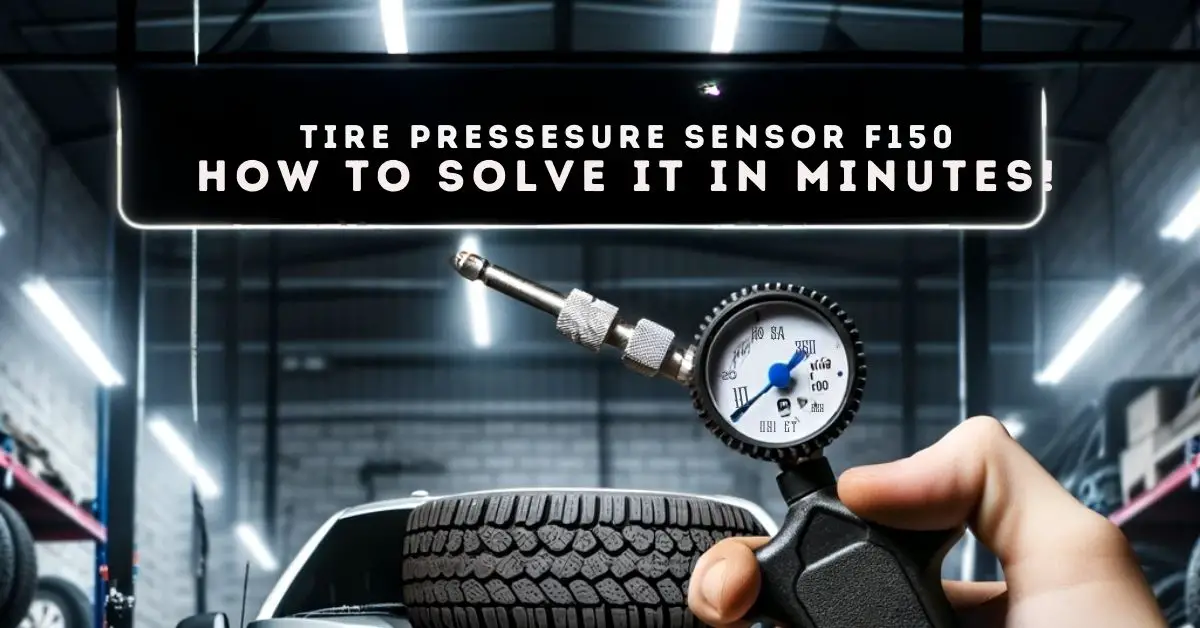Tire Pressure Sensor Fault F150
Last Updated on by Tarek
Ever noticed that pesky TPMS light flicker on your Ford F-150 dashboard? Don’t ignore it; it’s more than just an annoying light. We’re diving into everything you need to know about “Tire Pressure Sensor Fault F150.”
In this guide, you’ll find:
- Causes of TPMS faults in Ford F-150
- How to diagnose the issue
- How to Fix a TPMS Fault on a Ford F-150
- The Cost to Fix a TPMS Fault on a Ford F-150
- Preventative measures
- And Troubleshooting common TPMS problems
Stay tuned to keep that TPMS light off and your tires in perfect condition.
What Causes a TPMS Fault on a Ford F-150?
Understanding why your TPMS light is on is the first step toward resolving the issue. In this section, we explore the common causes of TPMS faults on a Ford F-150.
Low Tire Pressure
Low tire pressure is the most frequent culprit behind a lit TPMS light. But why should you care?
Consequences of Low Tire Pressure
| Consequence | Explanation |
|---|---|
| Decreased Fuel Efficiency | Less pressure leads to more road contact, making your engine work harder. |
| Reduced Handling | Your F-150 will feel sluggish during turns. |
| Tire Wear | Tires degrade faster when underinflated. |
Faulty TPMS Sensor
Sensors act as the system’s eyes and ears. A faulty one can give incorrect readings.
Lifespan of TPMS Sensors
| Lifespan | Influencing Factors |
|---|---|
| 5-10 years | Rough terrains can shorten sensor life. |
TPMS Control Module Issues
The control module is like the brain of the TPMS, interpreting sensor signals.
Role of the TPMS Control Module
| Role | Description |
|---|---|
| Data Gathering | Collects information from each sensor. |
| Analysis | Determines if tire pressure is within a safe range. |
| Alerts | Activates the TPMS light if needed. |
Wiring or Electrical Connection Problems
The wiring acts as the communication bridge between the sensors and the control module.
How Wiring Connects TPMS Components
| Component | Function |
|---|---|
| Wires | Transmit data from sensors to module. |
| Connectors | Transmit data from sensors to the module. |
Software Glitches
Even your TPMS can suffer from software issues.
Occurrence and Identification
| Issue | Solution |
|---|---|
| Software Bug | Usually fixed by a system reset. |
Diagnostic Importance
Knowing the cause of a TPMS fault isn’t merely for peace of mind; it’s vital for safe driving.
Why Immediate Action is Necessary
| Risk | Result |
| Ignoring TPMS Light | Could lead to accidents or higher costs. |
How to Diagnose a TPMS Fault on a Ford F-150
Wondering why that TPMS light is on? Here’s how to get to the root of the problem.
Checking Tire Pressure
Starting with tire pressure is often the quickest way to resolve a TPMS fault. Here’s what you’ll need.
Tools Needed
| Tool | Use |
|---|---|
| Tire Pressure Gauge | To measure the pressure in each tire |
Recommended PSI Levels
| Tire Position | Recommended PSI |
|---|---|
| Front | 35 |
| Rear | 35 |
Using a TPMS Scan Tool
If checking the tire pressure didn’t help, a TPMS scan tool can provide more insights.
Where to Get a TPMS Scan Tool
| Vendor | Price Range |
|---|---|
| Auto Parts Store | $50 – $200 |
| Online Retailers | $40 – $150 |
Inspection of TPMS Sensors and Wiring
Sometimes the issue lies in the hardware. Let’s explore what to look for.
Visual Cues for Damaged Sensors or Wires
| Visual Cues | Indication |
|---|---|
| Exposed Wires | Potential breakage |
| Corrosion on Sensor | Sensor failure |
Additional Tips
Still can’t figure it out? These scenarios might help you understand what’s going on.
Different Scenarios and What They Mean for Your TPMS
| Scenario | Implication |
|---|---|
| TPMS Light Flashing | Likely a sensor failure |
| TPMS Light On but Tires Are Fine | Possible control module issue |
How to Fix a TPMS Fault on a Ford F-150
If you’re staring down a stubborn TPMS light, don’t worry. Here’s a guide to putting that light to rest.
Checking and Adjusting Tire Pressure
Getting your tire pressure right is essential for turning off that TPMS light. Here’s how to do it.
Step-by-Step Guide
- Locate a Tire Pressure Gauge: Found at any auto parts store.
- Check Each Tire: Follow your vehicle’s recommended PSI.
- Adjust as Necessary: Use an air compressor to adjust the pressure.
| Step | Tool Needed | Action |
|---|---|---|
| 1 | Pressure Gauge | Measure |
| 2 | None | Compared to the Recommended PSI |
| 3 | Air Compressor | Adjust Pressure |
Resetting the TPMS
Sometimes, the TPMS needs a manual reset to recognize the changes you’ve made.
You can also check out the video:
For 2009-2014 Models
- Turn Ignition to ‘On’: Don’t start the engine.
- Press ‘Set’ Button: Until the TPMS light blinks three times.
- Wait: Until the light turns off.
For 2015-2021 Models
- Turn Ignition to ‘On’: Don’t start the engine.
- Press ‘OK’ Button: Until the TPMS light blinks twice.
- Wait: Until the light turns off.
Training the TPMS
Your TPMS might need to learn new sensor positions, especially after tire rotation or replacement.
Tools Needed
| Tool | Use |
|---|---|
| TPMS Tool | To activate each sensor |
Activation Sequence
- Turn Ignition Off
- Activate Sensors: In the order: left front, right front, right rear, left rear.
- Turn Ignition On: Wait for the TPMS light to turn off.
Replacing TPMS Sensors
When all else fails, it may be time for new TPMS sensors.
When and How to Replace
| When to Replace | How to Replace |
|---|---|
| Sensor battery is dead | Professional installation recommended |
| Physical damage to sensor | Remove tire to access sensor |
How Much Does It Cost to Fix a TPMS Fault on a Ford F-150?
The cost to fix a TPMS fault on a Ford F-150 can vary depending on the cause of the fault. If the fault is caused by a low tire pressure, it is free to fix. If the fault is caused by a faulty TPMS sensor or a problem with the TPMS control module, the cost to fix it can range from $100 to $300
How to Prevent TPMS Faults on a Ford F-150
Prevention is better than cure. Keep that TPMS light off with these preventive measures.
Regular Tire Pressure Checks
Keeping an eye on your tire pressure is the first line of defense against TPMS faults.
Frequency and Benefits
| Frequency | Benefits |
|---|---|
| Monthly | – Better Fuel Efficiency- Increased Tire Longevity |
Note: More frequent checks may be required in temperature extremes.
TPMS Sensor Replacement
Sensors don’t last forever. Know when to replace them to avoid TPMS issues.
Signs That Sensors Need Replacing
- Battery Warning: TPMS light flashes intermittently.
- Inconsistent Readings: Varying pressure readings for the same tire.
TPMS Reset after Tire Rotation
A simple tire rotation can confuse your TPMS. A reset can clear up any misunderstandings.
Why It’s Necessary
- Accurate Readings: Ensures the TPMS identifies the correct location of each tire.
- Safety: Helps in precise identification of under-inflated tires.
TPMS Training after Tire Replacement
Got new tires? Your TPMS needs to get acquainted with them.
Steps Involved
- Turn Ignition Off
- Activate Each Sensor: Use a TPMS tool.
- Turn Ignition On: Wait for the TPMS light to turn off.
Avoiding Overinflation
Too much of a good thing can be bad, and that includes tire pressure.
Risks and How to Prevent
| Risk | How to Prevent |
|---|---|
| Tire Blowout | Stick to the recommended PSI |
| Poor Handling | Regular pressure checks |
What Are Common Sensor Issues in Ford F150 and How Can I Troubleshoot Them?
If you are facing troubles with your Ford F150’s sensors, it is essential to troubleshoot ford f150 sensor issues promptly. Common problems include faulty oxygen sensors, mass airflow sensor malfunction, and ABS sensor failures. To resolve these issues, ensure proper sensor connections, clean sensors regularly, and consider replacing damaged sensors. Regular maintenance and monitoring can help you identify and troubleshoot sensor problems effectively for uninterrupted performance.
Can a Park Brake Malfunction Cause a Tire Pressure Sensor Fault on an F150?
A park brake malfunction service may not directly cause a tire pressure sensor fault on an F150. However, it’s essential to have both systems regularly inspected and maintained to prevent any potential issues. Addressing the park brake malfunction promptly and ensuring proper maintenance can help preserve the overall performance and safety of your F150.
How to Troubleshoot Common TPMS Faults on a Ford F-150
Running into TPMS issues on your Ford F-150? This comprehensive guide will help you identify and solve the most common problems.
Malfunctioning TPMS Sensors
One of the main culprits behind TPMS issues is malfunctioning sensors. Knowing how to identify and replace them can save you a lot of headaches.
How to Identify and Replace
- Intermittent Flashing: If the TPMS warning light on your dashboard is flashing intermittently, it’s often a sign of a dying battery in one of your TPMS sensors.
- Inconsistent Readings: If the sensor gives varying pressure readings for the same tire in a short time, consider replacing it.
- Replacement Procedure:
- Remove the tire valve cap and core.
- Remove and replace the TPMS sensor.
- Reinstall the valve core and cap.
- Reinflate the tire to the proper pressure.
Low Tire Pressure Issues
Low tire pressure is not just a common issue; it’s also a dangerous one that can affect your vehicle’s handling and fuel efficiency.
Confirmation and Steps for Resolution
Check with a Gauge:
Always confirm low tire pressure with a manual gauge.
Inflate to Recommended PSI:
Refer to your owner’s manual or the sticker on your driver’s side door jamb for the correct PSI.
Recheck with TPMS:
After inflation, the TPMS should automatically update. If not, you may need to drive a short distance to reset it.
TPMS System Reset Requirements
Sometimes your TPMS needs a “fresh start,” especially after tire rotations or replacements.
Scenarios That May Require a Reset
After Tire Rotation or Replacement: To ensure accurate readings.
After Sensor Replacement: New sensors often require a system reset.
Erratic Behavior: Unexplained or inconsistent warnings may require a system reset.
TPMS System Training Requirements
New tires or sensors mean your TPMS has to learn to recognize them. Here’s how to train your system.
When and How to Train the System
- When: After replacing one or multiple tires or after installing new TPMS sensors.
- How:
- Turn off the ignition.
- Use a TPMS tool to activate each sensor, following a specified sequence: left front, right front, right rear, left rear.
- Turn on the ignition and wait for the TPMS light to go off, indicating successful training.
Conclusion
So there you have it! Troubleshooting your Ford F-150’s TPMS doesn’t have to be a headache. With a little know-how and some hands-on action, you can tackle the most common issues yourself. From sensors playing tricks on you to keeping those tires at just the right pressure, you’re now equipped to keep that TPMS light off and hit the road with peace of mind. Safe travels!





